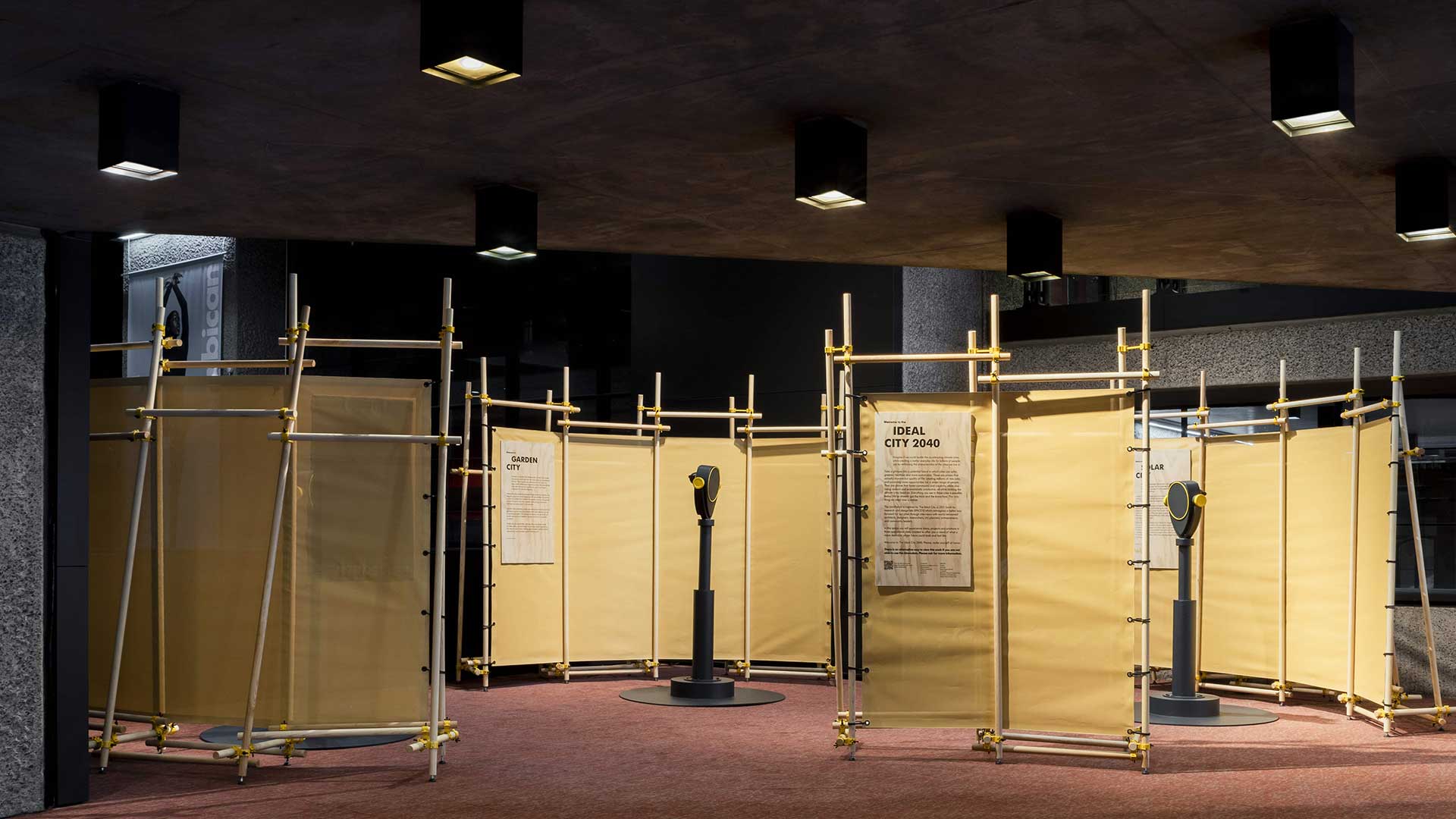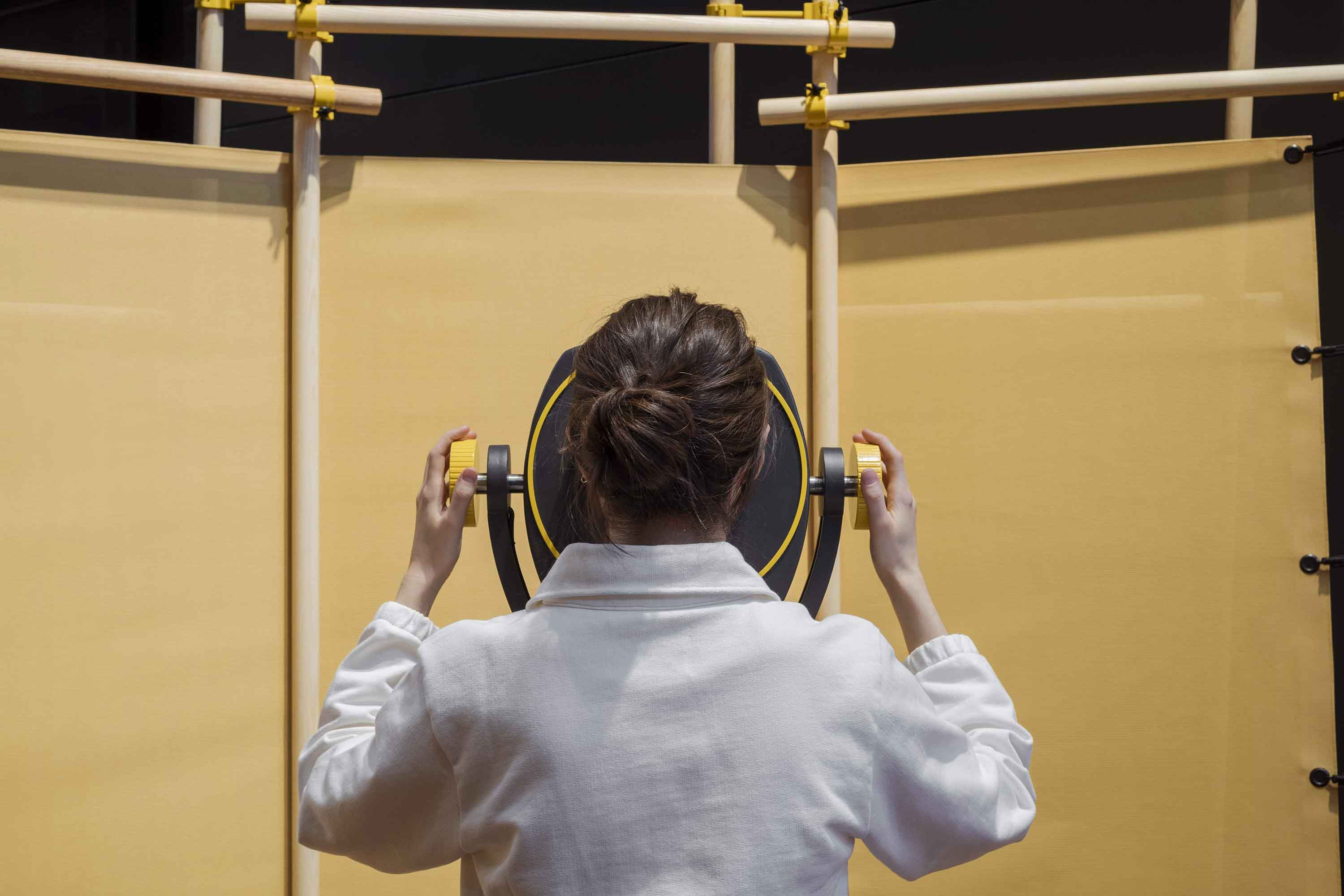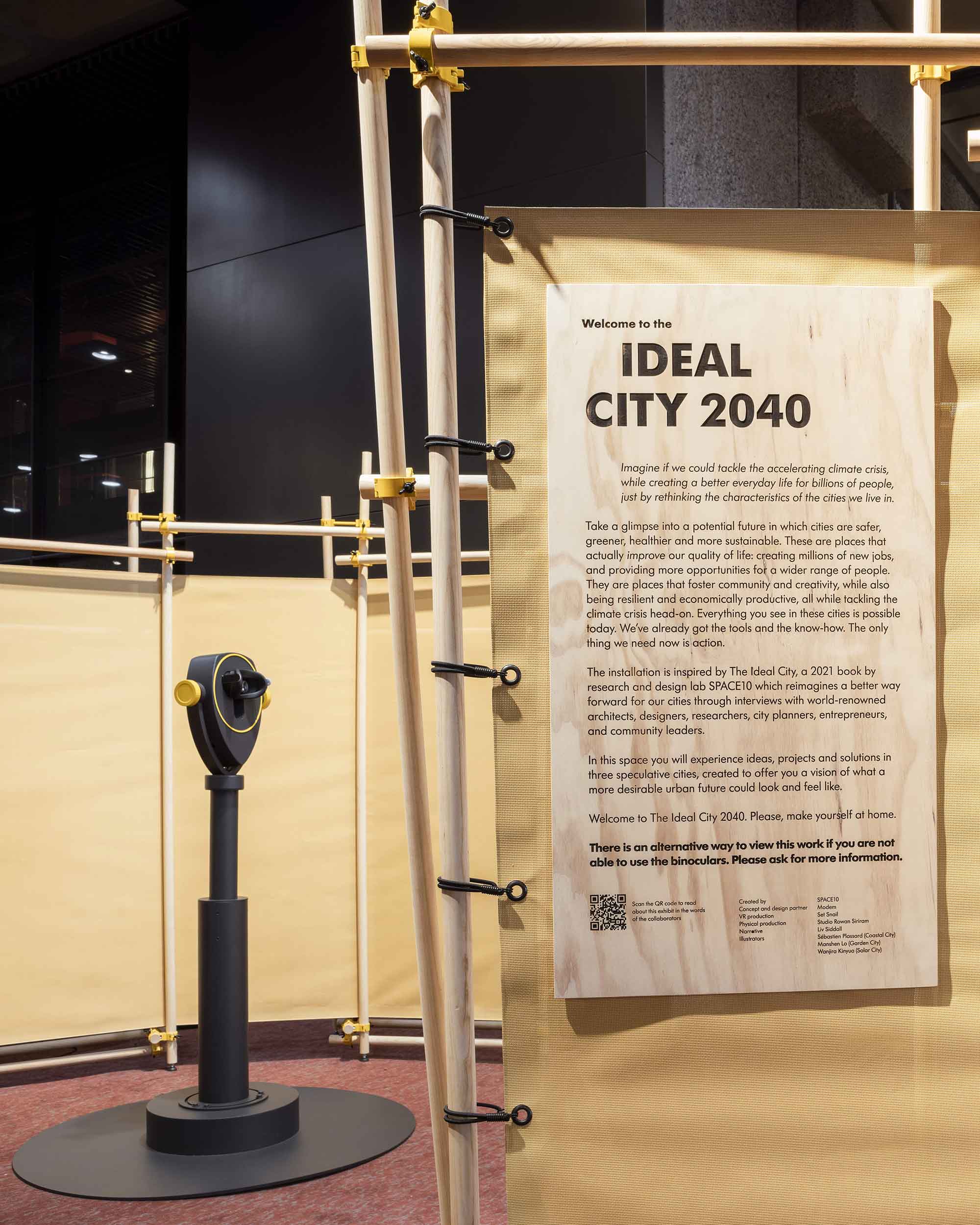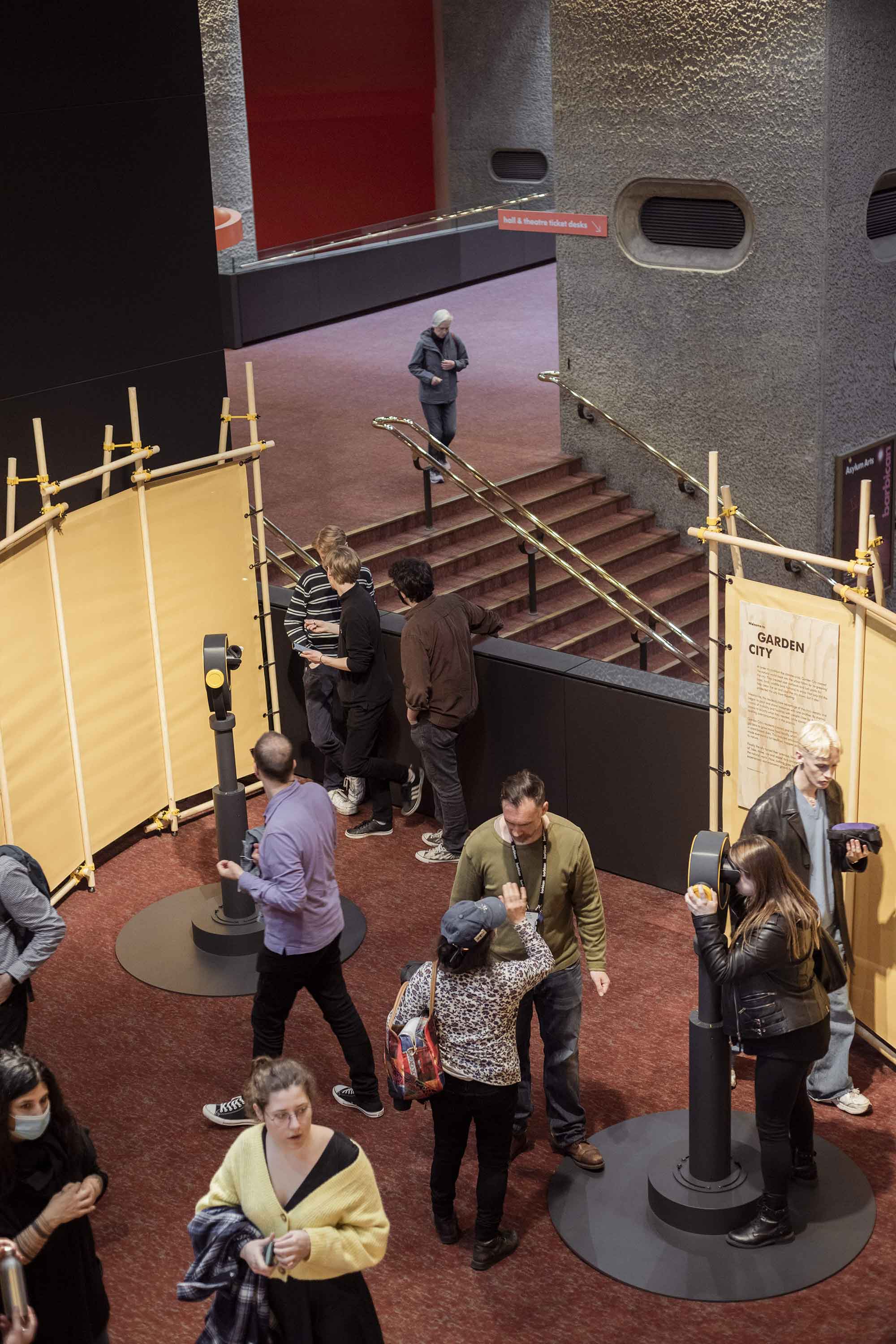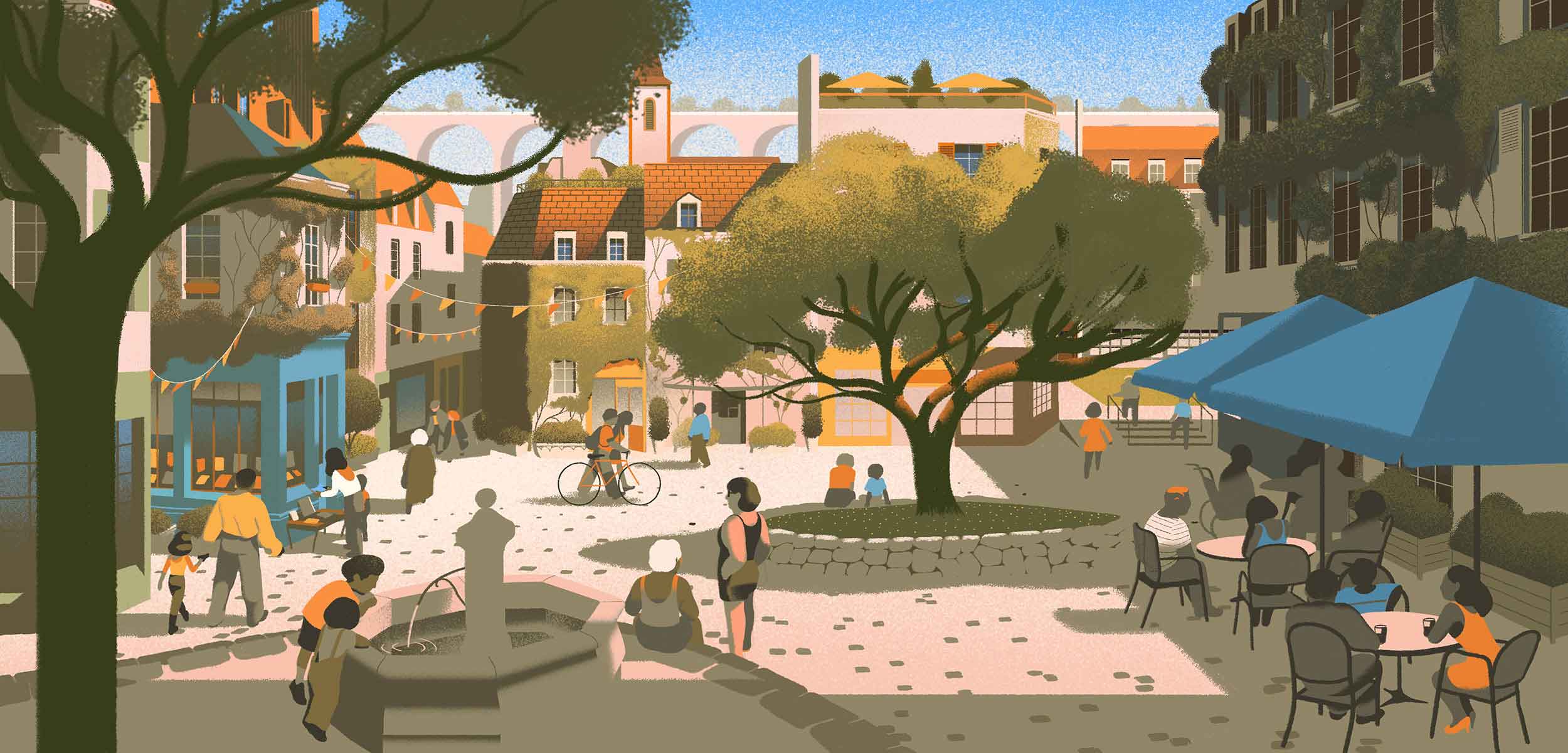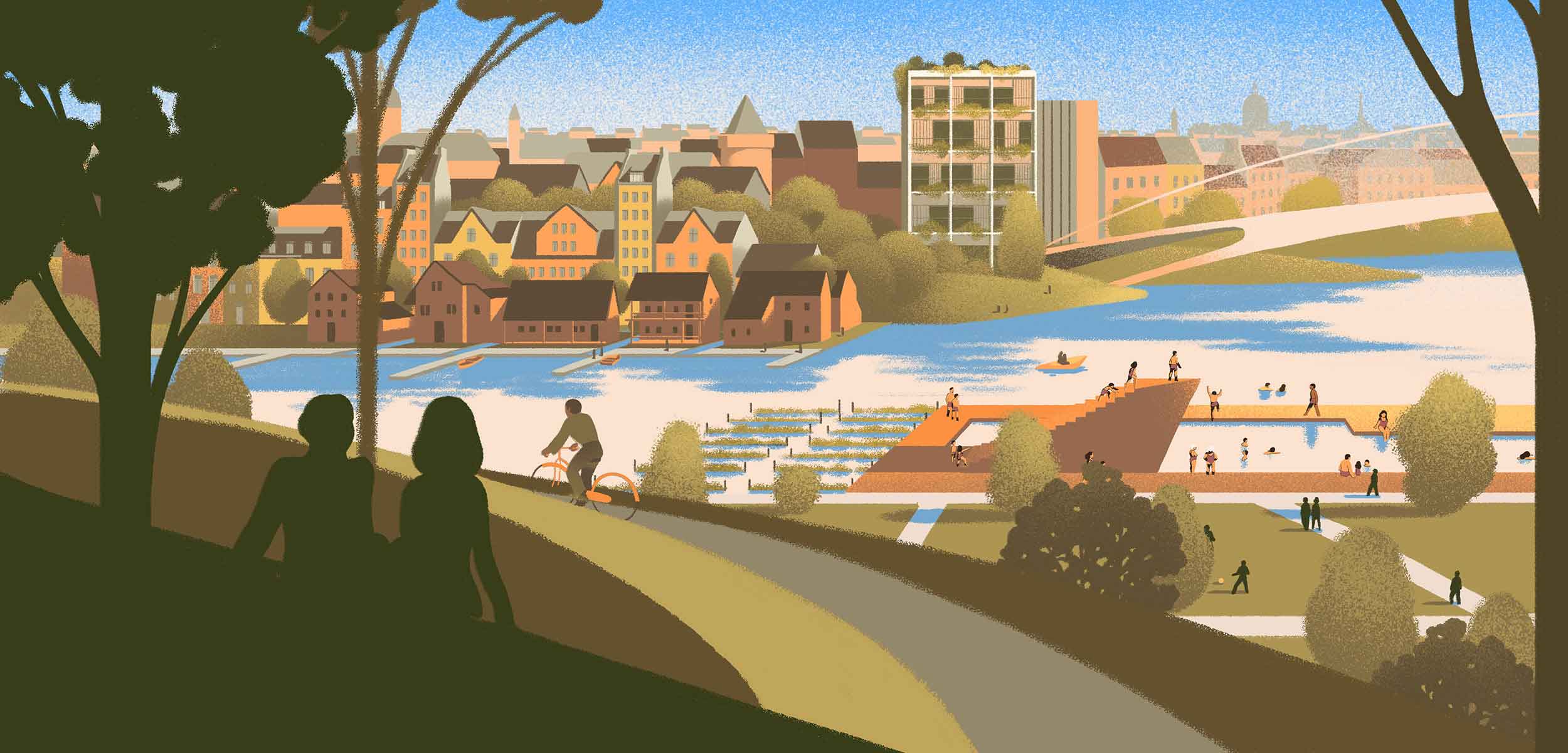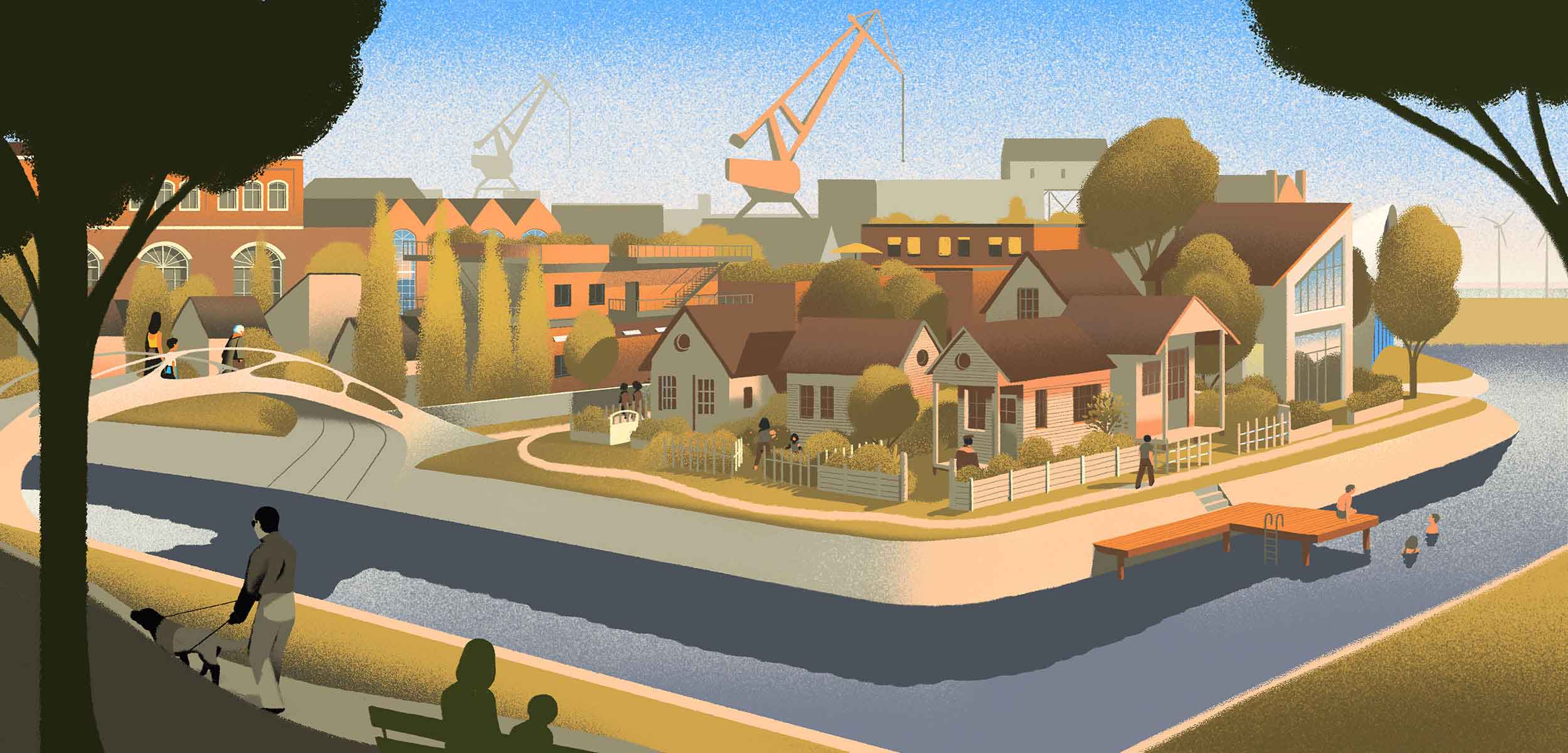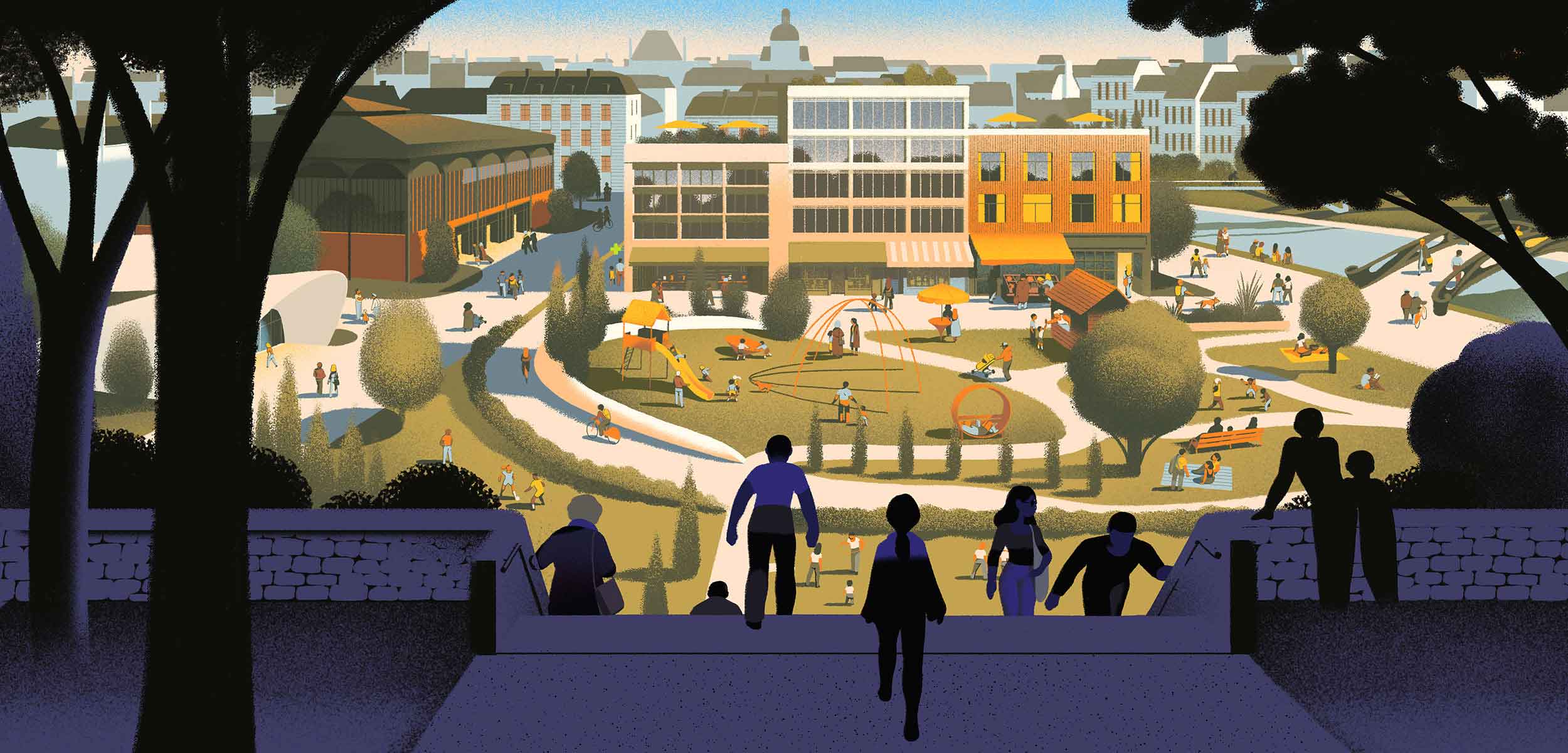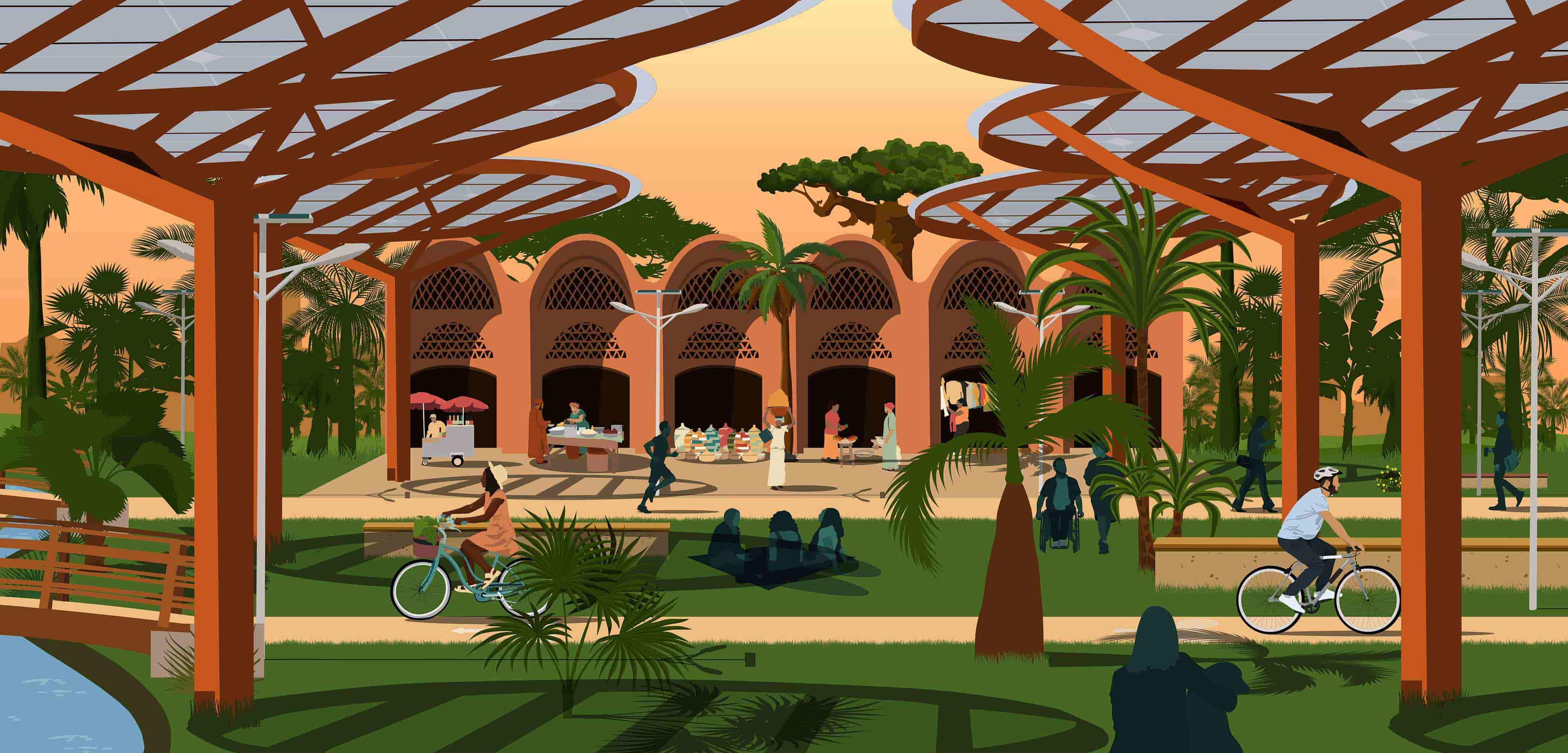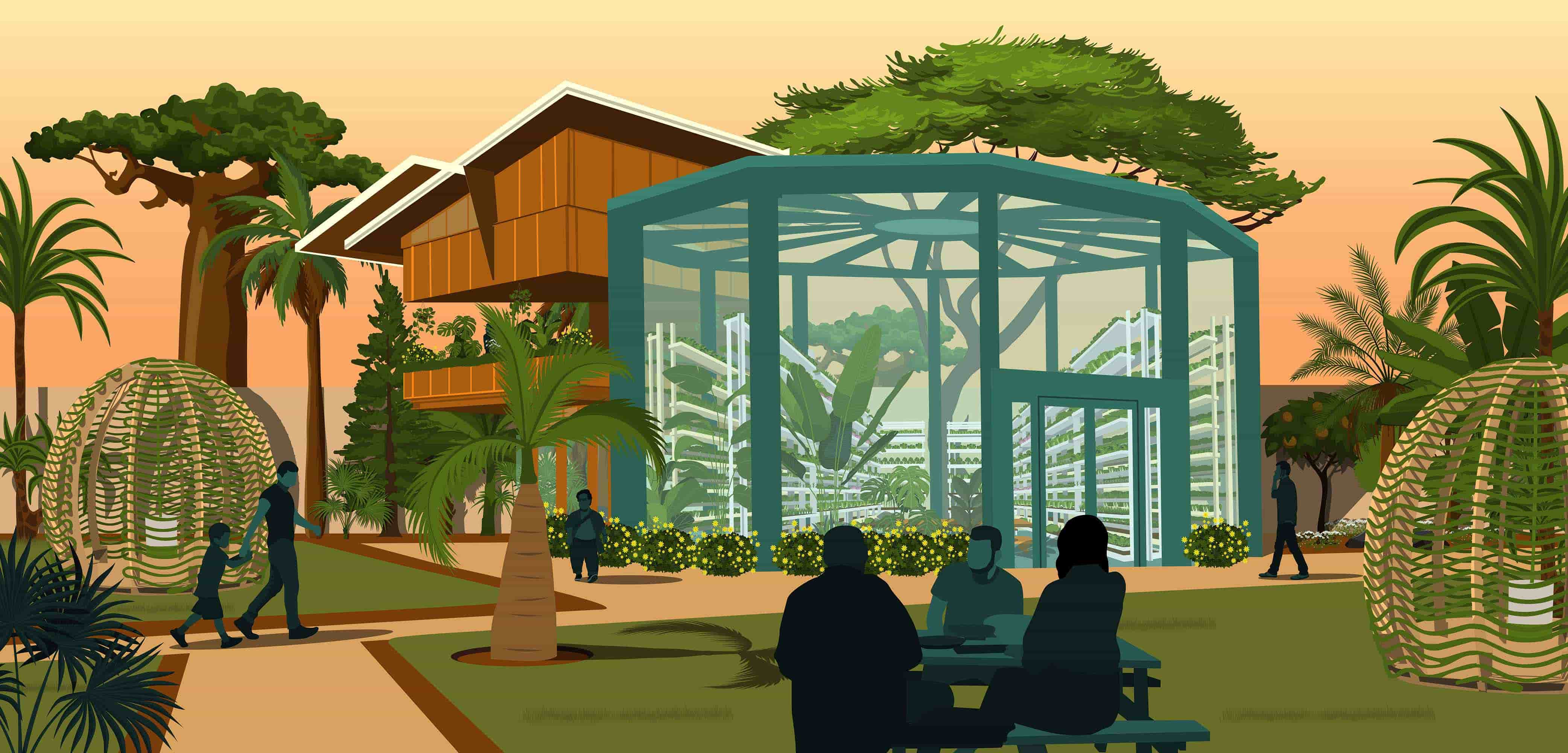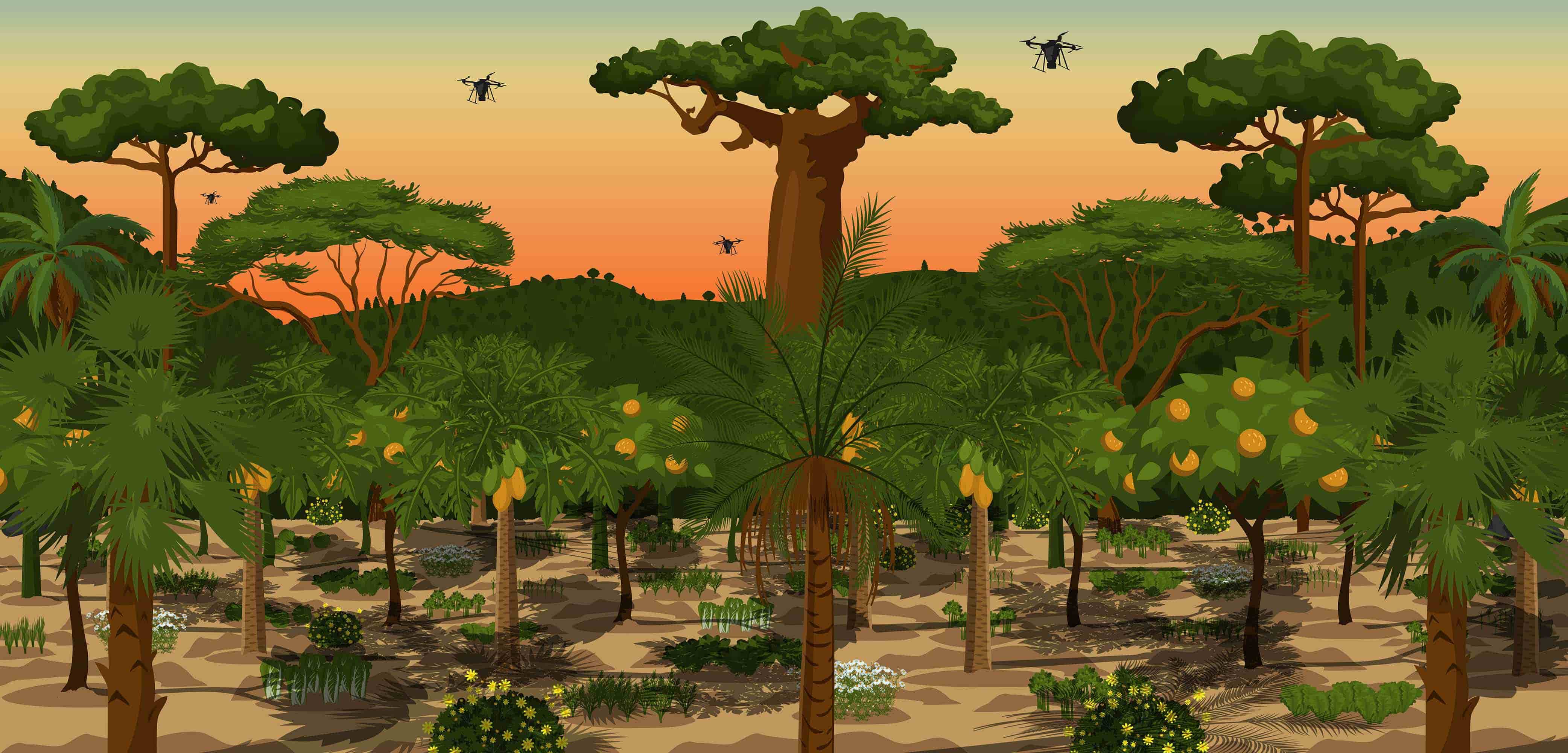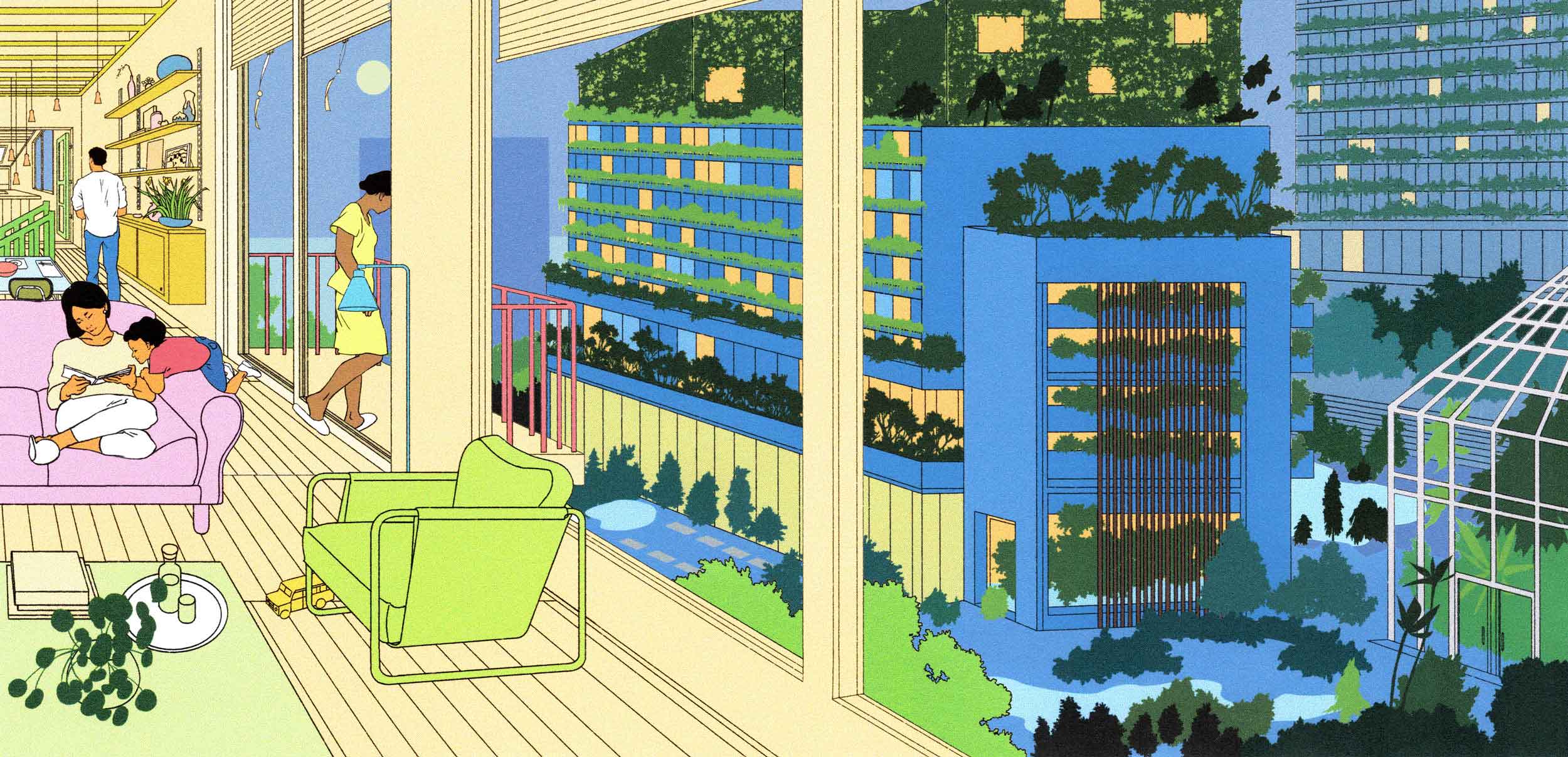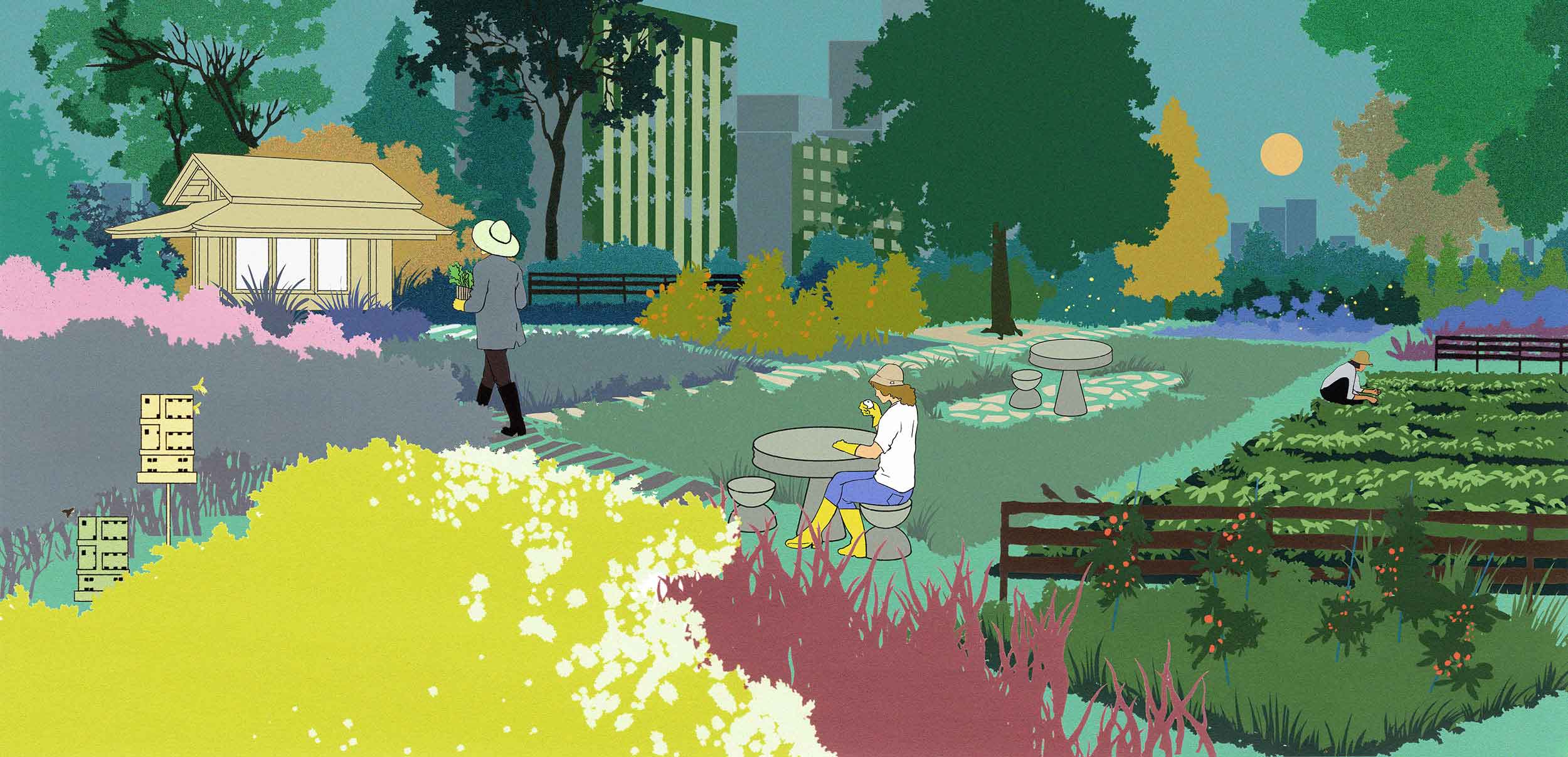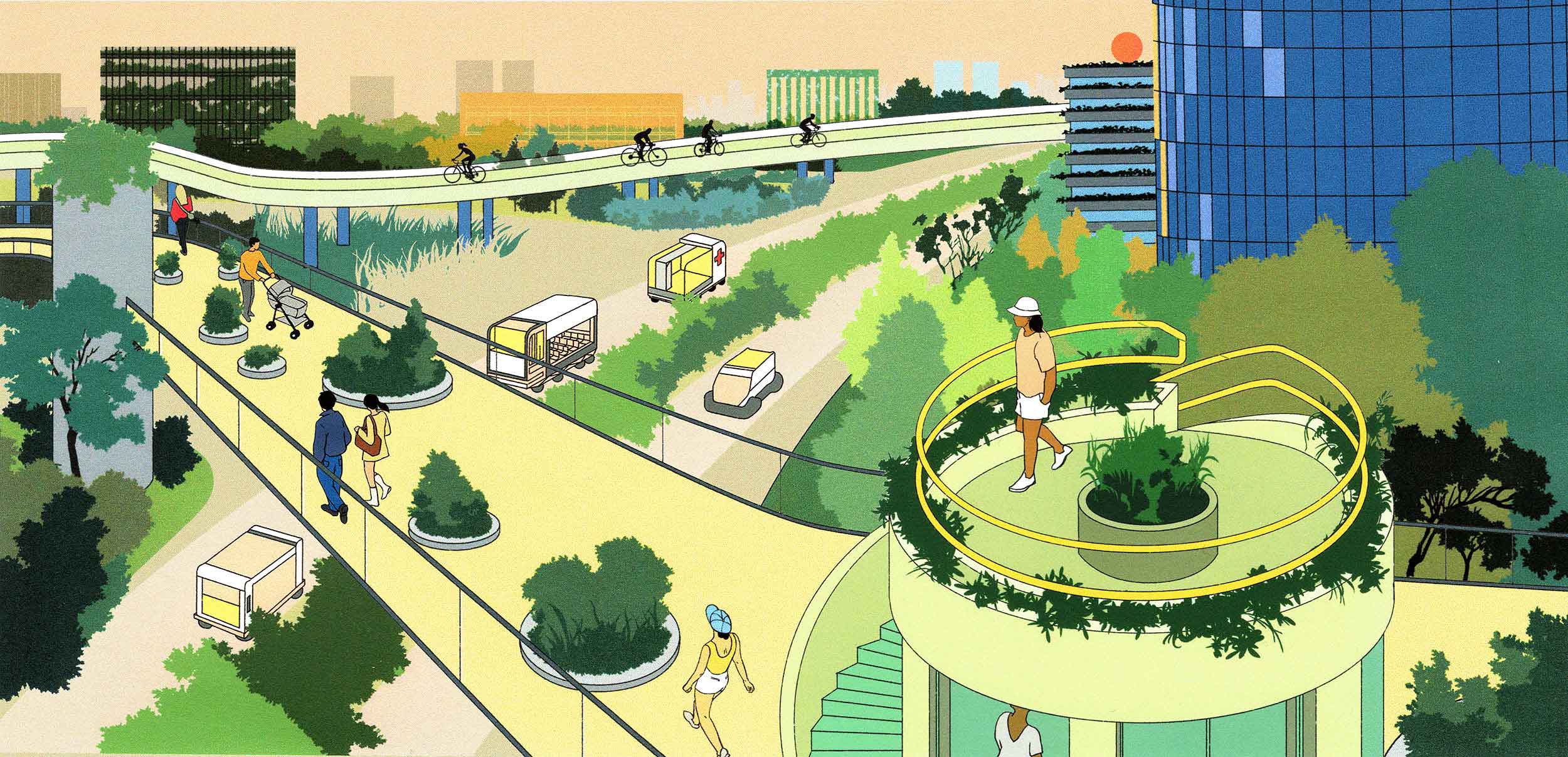Copenhagen based research and design lab SPACE10 present The Ideal City 2040, an interactive installation that makes the recommendations from the newest IPCC more tangible for a general audience. The installation will travel to venues around the world, beginning with its debut at The Barbican Centre’s exhibition Our Time on Earth. According to the Intergovernmental Panel on Climate Change report released on April 4, tackling climate change will mean rethinking how cities are designed and function. In partnership with design and innovation office Modem, SPACE10 invites people to visit three utopian cities in the year 2040 viewed through virtual reality binoculars. The installation not only reveals how cities would look and feel if the UN’s recommendations for urban landscapes were implemented but also how they have greatly improved the quality of life for people.
SPACE10 worked with three illustrators from three parts of the world, who brought the vision to life by depicting how cities have tackled the accelerating climate crisis while creating a better everyday life for the people who live there. Artists Sébastien Plassard, Manshen Lo and Wanjira Kinyua, illustrate tangible examples that can be found in the IPCC report, from the 15-Minute city, to how to regreen cities, retrofit buildings, and revitalise land through regenerative agriculture. The project shows through illustrations what a more desirable urban future could look and feel like – and how we get there together.
Coastal City
Coastal City addressed the climate crisis by creating a mixed and well-planned urban landscape, where everything its residents need on a daily basis is just a short walk away. Pavements are wider, and with protected bike lanes and efficient public transportation, people no longer need to rely on private cars to get around. This in turn frees up space for parks, playgrounds and plazas. The city’s power now comes from off-shore wind, solar energy, and other clean energy sources, while the old buildings have been retrofitted to be a lot more energy-efficient. Construction is predominantly completed using wood and other organic materials, rather than cement, steel and concrete. Lastly, time and effort were poured into finding ways to protect the city from rising sea levels and floods, eradicating pollution and restoring dwindling sea life in the process. All in all, it’s a happy, community-oriented place that prioritises a high quality of life for its citizens.
Solar City
Solar City addressed the climate crisis by taking advantage of something they had an unlimited resource of the sun. The city now powers all of its needs through clean, renewable energy. Today, local and indigenous knowledge is what informs decision-making. This means rethinking attitudes to architecture and making use of locally-available biomaterials. The city also began reversing the desertification of the region: revitalising the land and increasing its water retention to preserve biodiversity and grow more food locally. Vertical hydroponic farms were built, too. They can grow greens three times faster than traditional farming methods, while also using 90% less water and requiring zero soil. One of the most powerful ways Solar City fought climate change was by bringing equality to the education system. Equipping all children with knowledge and skills is key to unlocking the potential of every citizen. The city enabled both girls and boys to receive a quality education and encouraged every child to stay in school for as long as possible, rather than starting large families at a young age.
Garden City
In order to confront the climate crisis, Garden City coaxed the natural world back into the urban fabric by ‘re-greening’ the city. They created vast wetlands and lush parks for bees, birds, wildlife (and humans) to enjoy. Not only did this help clean the air and cool the city down, but it also protected the city from flooding. Meanwhile, the residents took advantage of the city’s density and began to pool and share resources with one another. By sharing modes of mobility and facilities with people close by, they gained access to exactly what they needed, while saving money and tackling overconsumption in the process. Garden City’s residents created and maintained shared community gardens to grow more food locally, which also resulted in a rise in plant-based diets. This reduced emissions, and generally just made everyone a lot healthier, happier and more connected to nature. Finally, the city turned their previous, linear economic model of ‘take, make, use and waste’ into a circular system inspired by the natural world. Now, nothing goes to waste and the city has experienced vast economic growth because of it.
Copenhagen based research and design lab SPACE10 present The Ideal City 2040, an interactive installation that makes the recommendations from the newest IPCC more tangible for a general audience. The installation will travel to venues around the world, beginning with its debut at The Barbican Centre’s exhibition Our Time on Earth. According to the Intergovernmental Panel on Climate Change report released on April 4, tackling climate change will mean rethinking how cities are designed and function. In partnership with design and innovation office Modem, SPACE10 invites people to visit three utopian cities in the year 2040 viewed through virtual reality binoculars. The installation not only reveals how cities would look and feel if the UN’s recommendations for urban landscapes were implemented but also how they have greatly improved the quality of life for people.
SPACE10 worked with three illustrators from three parts of the world, who brought the vision to life by depicting how cities have tackled the accelerating climate crisis while creating a better everyday life for the people who live there. Artists Sébastien Plassard, Manshen Lo and Wanjira Kinyua, illustrate tangible examples that can be found in the IPCC report, from the 15-Minute city, to how to regreen cities, retrofit buildings, and revitalise land through regenerative agriculture. The project shows through illustrations what a more desirable urban future could look and feel like – and how we get there together.
Coastal City
Coastal City addressed the climate crisis by creating a mixed and well-planned urban landscape, where everything its residents need on a daily basis is just a short walk away. Pavements are wider, and with protected bike lanes and efficient public transportation, people no longer need to rely on private cars to get around. This in turn frees up space for parks, playgrounds and plazas. The city’s power now comes from off-shore wind, solar energy, and other clean energy sources, while the old buildings have been retrofitted to be a lot more energy-efficient. Construction is predominantly completed using wood and other organic materials, rather than cement, steel and concrete. Lastly, time and effort were poured into finding ways to protect the city from rising sea levels and floods, eradicating pollution and restoring dwindling sea life in the process. All in all, it’s a happy, community-oriented place that prioritises a high quality of life for its citizens.
Solar City
Solar City addressed the climate crisis by taking advantage of something they had an unlimited resource of the sun. The city now powers all of its needs through clean, renewable energy. Today, local and indigenous knowledge is what informs decision-making. This means rethinking attitudes to architecture and making use of locally-available biomaterials. The city also began reversing the desertification of the region: revitalising the land and increasing its water retention to preserve biodiversity and grow more food locally. Vertical hydroponic farms were built, too. They can grow greens three times faster than traditional farming methods, while also using 90% less water and requiring zero soil. One of the most powerful ways Solar City fought climate change was by bringing equality to the education system. Equipping all children with knowledge and skills is key to unlocking the potential of every citizen. The city enabled both girls and boys to receive a quality education and encouraged every child to stay in school for as long as possible, rather than starting large families at a young age.
Garden City
In order to confront the climate crisis, Garden City coaxed the natural world back into the urban fabric by ‘re-greening’ the city. They created vast wetlands and lush parks for bees, birds, wildlife (and humans) to enjoy. Not only did this help clean the air and cool the city down, but it also protected the city from flooding. Meanwhile, the residents took advantage of the city’s density and began to pool and share resources with one another. By sharing modes of mobility and facilities with people close by, they gained access to exactly what they needed, while saving money and tackling overconsumption in the process. Garden City’s residents created and maintained shared community gardens to grow more food locally, which also resulted in a rise in plant-based diets. This reduced emissions, and generally just made everyone a lot healthier, happier and more connected to nature. Finally, the city turned their previous, linear economic model of ‘take, make, use and waste’ into a circular system inspired by the natural world. Now, nothing goes to waste and the city has experienced vast economic growth because of it.
Copenhagen based research and design lab SPACE10 present The Ideal City 2040, an interactive installation that makes the recommendations from the newest IPCC more tangible for a general audience. The installation will travel to venues around the world, beginning with its debut at The Barbican Centre’s exhibition Our Time on Earth. According to the Intergovernmental Panel on Climate Change report released on April 4, tackling climate change will mean rethinking how cities are designed and function. In partnership with design and innovation office Modem, SPACE10 invites people to visit three utopian cities in the year 2040 viewed through virtual reality binoculars. The installation not only reveals how cities would look and feel if the UN’s recommendations for urban landscapes were implemented but also how they have greatly improved the quality of life for people.
SPACE10 worked with three illustrators from three parts of the world, who brought the vision to life by depicting how cities have tackled the accelerating climate crisis while creating a better everyday life for the people who live there. Artists Sébastien Plassard, Manshen Lo and Wanjira Kinyua, illustrate tangible examples that can be found in the IPCC report, from the 15-Minute city, to how to regreen cities, retrofit buildings, and revitalise land through regenerative agriculture. The project shows through illustrations what a more desirable urban future could look and feel like – and how we get there together.
Coastal City
Coastal City addressed the climate crisis by creating a mixed and well-planned urban landscape, where everything its residents need on a daily basis is just a short walk away. Pavements are wider, and with protected bike lanes and efficient public transportation, people no longer need to rely on private cars to get around. This in turn frees up space for parks, playgrounds and plazas. The city’s power now comes from off-shore wind, solar energy, and other clean energy sources, while the old buildings have been retrofitted to be a lot more energy-efficient. Construction is predominantly completed using wood and other organic materials, rather than cement, steel and concrete. Lastly, time and effort were poured into finding ways to protect the city from rising sea levels and floods, eradicating pollution and restoring dwindling sea life in the process. All in all, it’s a happy, community-oriented place that prioritises a high quality of life for its citizens.
Solar City
Solar City addressed the climate crisis by taking advantage of something they had an unlimited resource of the sun. The city now powers all of its needs through clean, renewable energy. Today, local and indigenous knowledge is what informs decision-making. This means rethinking attitudes to architecture and making use of locally-available biomaterials. The city also began reversing the desertification of the region: revitalising the land and increasing its water retention to preserve biodiversity and grow more food locally. Vertical hydroponic farms were built, too. They can grow greens three times faster than traditional farming methods, while also using 90% less water and requiring zero soil. One of the most powerful ways Solar City fought climate change was by bringing equality to the education system. Equipping all children with knowledge and skills is key to unlocking the potential of every citizen. The city enabled both girls and boys to receive a quality education and encouraged every child to stay in school for as long as possible, rather than starting large families at a young age.
Garden City
In order to confront the climate crisis, Garden City coaxed the natural world back into the urban fabric by ‘re-greening’ the city. They created vast wetlands and lush parks for bees, birds, wildlife (and humans) to enjoy. Not only did this help clean the air and cool the city down, but it also protected the city from flooding. Meanwhile, the residents took advantage of the city’s density and began to pool and share resources with one another. By sharing modes of mobility and facilities with people close by, they gained access to exactly what they needed, while saving money and tackling overconsumption in the process. Garden City’s residents created and maintained shared community gardens to grow more food locally, which also resulted in a rise in plant-based diets. This reduced emissions, and generally just made everyone a lot healthier, happier and more connected to nature. Finally, the city turned their previous, linear economic model of ‘take, make, use and waste’ into a circular system inspired by the natural world. Now, nothing goes to waste and the city has experienced vast economic growth because of it.







 Sign in with email
Sign in with email


